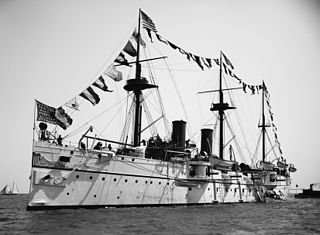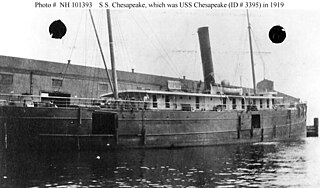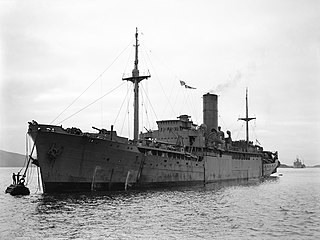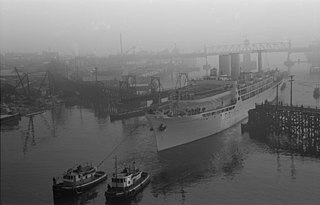
The fourth USS Baltimore (C-3) was a United States Navy cruiser, the fifth protected cruiser to be built by an American yard. Like the previous one, Charleston, the design was commissioned from the British company of W. Armstrong, Mitchell, and Company of Newcastle. Baltimore was an all-around improvement on Charleston, somewhat larger with more guns, thicker armor, and better machinery.

Minelaying is the act of deploying explosive mines. Historically this has been carried out by ships, submarines and aircraft. Additionally, since World War I the term minelayer refers specifically to a naval ship used for deploying naval mines. "Mine planting" was the term for installing controlled mines at predetermined positions in connection with coastal fortifications or harbor approaches that would be detonated by shore control when a ship was fixed as being within the mine's effective range.

USS Oglala (ID-1255/CM-4/ARG-1) was a minelayer in the United States Navy. Commissioned as Massachusetts, she was renamed Shawmut a month later, and in 1928, was renamed after the Oglala, a sub-tribe of the Lakota, residing in the Black Hills of South Dakota.

The first USS San Francisco (C-5) was a steel protected cruiser in the United States Navy. She was later named Tahoe and then Yosemite, becoming the third US Navy ship to bear the name Yosemite. She generally resembled her predecessor Newark, with a main armament of twelve 6-inch guns.

The North Sea Mine Barrage, also known as the Northern Barrage, was a large minefield laid easterly from the Orkney Islands to Norway by the United States Navy during World War I. The objective was to inhibit the movement of U-boats from bases in Germany to the Atlantic shipping lanes bringing supplies to the British Isles. Rear Admiral Lewis Clinton-Baker, commanding the Royal Navy minelaying force at the time, described the barrage as the "biggest mine planting stunt in the world's history." Larger fields with greater numbers of mines were laid during World War II.

USS Aroostook (ID-1256/CM-3/AK-44) was the Eastern Steamship Company's Bunker Hill converted for planting the World War I North Sea Mine Barrage. Bunker Hill was built in 1907 at Philadelphia, Pennsylvania for passenger service between Boston and New York City. Bunker Hill was one of three sister ships, the others being Massachusetts and Old Colony, delivered as passenger/cargo ships by William Cramp & Sons in 1907. They were among the eight ships acquired by the U.S. Navy in November 1917. Bunker Hill and Massachusetts were converted to minelayers at the Boston Navy Yard. Old Colony was used as a district scout until sent across the Atlantic and turned over to the British in 1919.

The second USS Ardent (AM-340) was a Auk-class minesweeper in the United States Navy.

USS Auk (AM-38) was a Lapwing-class minesweeper acquired by the U.S. Navy after World War I for the task of removing mines that had been placed during the war.

The second USS Canonicus was the Southern Pacific freighter El Cid temporarily converted for planting the World War I North Sea Mine Barrage. Newport News Shipbuilding and Dry Dock Company launched El Cid at Newport News, Virginia on 7 October 1899 for service between New York City and Gulf of Mexico seaports of New Orleans and Galveston, Texas. The United States Shipping Board took control of the ship from Southern Pacific Steamship Company in 1917.

The third USS Chesapeake (ID-3395) was a United States Navy salvage ship in commission from March to October 1919.

SS Port Quebec was under construction for the Port Line when she was requisitioned by the Ministry of War Transport for completion as the auxiliary minelayer HMS Port Quebec. She joined the Royal Navy 1st Minelaying Squadron based at Kyle of Lochalsh laying mines for the World War II Northern Barrage. After minelaying was completed in October 1943, she was retained for conversion to a repair ship and renamed HMS Deer Sound (F99) in 1944. She was then returned to the Port Line in 1947.
USS Ozama was a naval mine carrier that served in the United States Navy from 1917 to 1919.

The second USS Kiowa (ID-1842) was a cargo ship that served in the United States Navy from 1918 to 1919.

United States Navy operations during World War I began on April 6, 1917, after the formal declaration of war on the German Empire. The American navy focused on countering enemy U-boats in the Atlantic Ocean and the Mediterranean Sea, while convoying men and supplies to France and Italy. Because of United States' late entry into the war, her capital ships never engaged the German fleet, and few decisive submarine actions occurred.

The second USS Housatonic was the Southern Pacific Steamship Company freighter El Rio. The ship was one of four company ships temporarily converted for planting the World War I North Sea Mine Barrage.
The third USS Roanoke was the Southern Pacific freighter El Dia temporarily converted for planting the World War I North Sea Mine Barrage. Newport News Shipbuilding and Dry Dock Company launched El Dia at Newport News, Virginia on 30 August 1911 for service between New York City and Gulf of Mexico seaports of New Orleans and Galveston, Texas. The United States Shipping Board took control of the ship from Southern Pacific Steamship Company in 1917.
The second USS Canandaigua was the Southern Pacific freighter El Siglo temporarily converted for planting the World War I North Sea Mine Barrage. Newport News Shipbuilding and Dry Dock Company launched El Siglo at Newport News, Virginia in May 1901 for service between New York City and Gulf of Mexico seaports of New Orleans and Galveston, Texas. The United States Shipping Board took control of the ship from Southern Pacific Steamship Company in 1917.
The third USS Saranac was the Old Dominion Steamship Company Hamilton temporarily converted for planting the World War I North Sea Mine Barrage. John Roach & Sons launched Hamilton at Chester, Pennsylvania in 1899. Hamilton steamed between Norfolk, Virginia and New York City until The United States Shipping Board took control of the ship from Old Dominion Steamship Company in 1917. She was fitted out for United States Navy service by James Shewan & Sons at Brooklyn, New York. The minelaying conversion enabled her to carry mines on two decks, and included four Otis elevators individually capable of transferring two mines every 20 seconds from the storage deck to the launching deck. USS Saranac was commissioned on 9 April 1918 with Captain Sinclair Gannon, USN, in command. While operating as part of Mine Squadron 1 out of Inverness, Scotland, from 14 July until the close of the war on 11 November 1918, Saranac laid a total of 4,782 mines:

MV Agamemnon was a cargo liner launched in 1929 for the Blue Funnel Line between United Kingdom ports and the Far East. She was requisitioned by the Royal Navy for conversion to the auxiliary minelayer HMS Agamemnon. She joined the 1st Minelaying Squadron based at Kyle of Lochalsh laying mines for the World War II Northern Barrage. When minelaying was completed in October 1943, she was retained for conversion to an amenities ship as part of a mobile naval base for British Pacific Fleet warships. She underwent further conversion at Vancouver in 1944 including installation of a movie theater and canteen to be staffed by mercantile crews of the Royal Fleet Auxiliary service. Conversion was incomplete when hostilities with Japan ended, and she was returned to Blue Funnel Line in 1946.

MV Menestheus was a Blue Funnel Liner launched in 1929. She was requisitioned by the Royal Navy for conversion to the auxiliary minelayer HMS Menestheus. She joined the 1st Minelaying Squadron based at Kyle of Lochalsh laying mines for the World War II Northern Barrage. When minelaying was completed in October 1943, she was retained for conversion to an amenities ship as part of a mobile naval base for British Pacific Fleet warships. She underwent further conversion at Vancouver in 1944 including installation of a movie theater and canteen staffed by mercantile crews of the Royal Fleet Auxiliary service. Conversion included a brewery to make beer for shipboard consumption. The ship had been painted grey for service in the North Atlantic, but was repainted white for service in the western Pacific. Conversion was incomplete when hostilities with Japan ended, and she was returned to Blue Funnel Line in 1946.

















